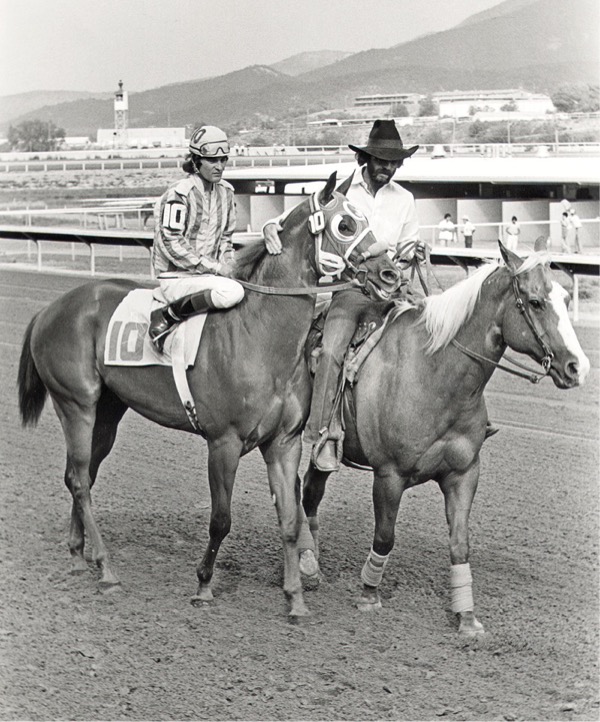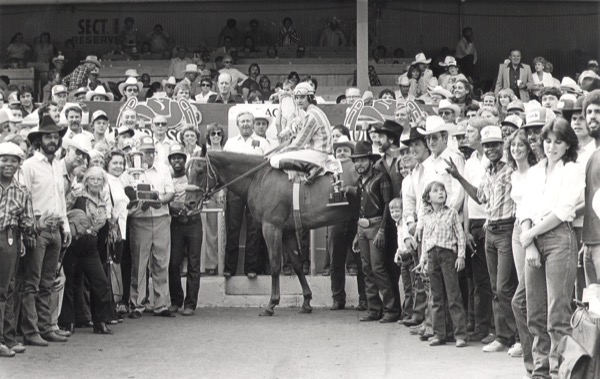JETTING TO RUIDOSO
Some stars from the Jet Deck line: an All American longshot and Quarter Horse racing’s first millionaire.
By Lesli Groves
Editor’s Note: Since the June issue, we’ve been exploring the line of speed horses that began with Top Deck (TB), then went on to Moon Deck, Jet Deck and Easy Jet. Now, in anticipation of Quarter Horse racing’s richest weekend – the All American in Ruidoso, New Mexico – we’ll spotlight two more “Jet” horses who made names for themselves there. Visit www.aqha.com/racing to learn more about this year’s All American races, held Labor Day weekend.

AQHA FILE PHOTO
Higheasterjet made history by winning all three All American races, the Futurity, Derby and Gold Cup.
Thoroughbred racing is known as the sport of kings. By comparison, American Quarter Horse racing is proudly democratic.
The All American Futurity, the sport’s richest race, has changed the lives of scrap-metal dealers, cowboys and schoolteachers. An annual event in Ruidoso, New Mexico, each Labor Day since 1959, the race has made the nouveau riche a little richer – but there’s always at least one Cinderella at the ball.

Jack Byers of Blanchard, Oklahoma, was a 70-year-old retired backhoe operator when his homebred mare Possumjet won the 1972 All American. Byers was a wiry little man, immune to fashion. Most of his wrinkles pointed toward his mouth and the hand-rolled cigarette that was frequently suspended there. In the win photos, Byers looks more like Possumjet’s groom than a big-time racehorse owner. But then, he was her groom – the only groom or trainer she’d ever known.
He also bred and raised her, as well as her mother, grandmother and great-grandmother. Usually, he was playing with a one-mare broodmare band and a couple of cowponies. Besides driving a backhoe for the county, he ran a few cows, shod some horses and doctored cattle for other ranchers.
“I made a good livin’, but, dogs, I worked for it,” Byers told Quarter Horse Journal writer Jim Scarbrough in 1972.

AQHA FILE PHOTO
The homebred and -trained Possumjet is one of the longest shots to ever win the All American Futurity.
Byers started Possumjet’s maternal line with My Pal Byers, foaled in ’47 and registered with the National Quarter Horse Association (which was absorbed into AQHA in 1949).
“This was the craziest old mare I ever had my hands on,” Byers said. “(I) tied her up to a heavy gate and she spooked, dragged that gate off and I figured that was the end of her. To heck with that kind of nonsense, I made a broodmare out of her.”
The flighty mare’s only registered foal was Byers’ Red Ant, by the Blackburn son Red Wolf. Byers got the racehorse bug when his daughter married Boyd Morris, the jockey who rode Decketta to an All American win in 1964. For a $200 fee, he bred Byers’ Red Ant to Parr Passum, which netted Susie Possum.

Susie Possum was a respectable race mare, and her first foal earned $53,151. So Byers aimed higher.
“I coughed up that $2,500 to breed to Jet Deck,” said Byers. “That sure was a lot of money to spend on stud fees.”
His return on the investment was Possumjet. When it came time to start her, his “first call” rider/son-in-law was injured. For two months, Byers hauled Possumjet 55 miles to Ratliff City, Oklahoma, for Pete Herrera to ride. On January 1, 1972, Possumjet won her trial and was second in the Blue Ribbon Futurity, worth $17,274.
She wasn’t as impressive in futurities in Columbus, Ohio, and Raton and Sunland Park, New Mexico, so many were surprised when Byers – who’d hesitated on a $2,500 stud fee – relinquished $12,500 to supplement her to the All American. He stayed with her practically ’round the clock.
“I liked to starved to death,” said Byers. “I couldn’t hardly go to the kitchen to eat without her walkin’ the stall something terrible.”
Lela Barnes, a fellow Oklahoman, took Byers homemade cornbread and milk to soothe and fill his stomach.
Once Possumjet won her trial and qualified for the final, Byers’ gamble was justified. Last place paid $28,000. And last place is where the bettors figured she’d be.
Sent off at 21-1, Possumjet remains, nearly 50 years later, one of the longest long shots to win the All American.
Higheasterjet
Pine’s Easter Jet sired 11 foals born in 1978. Four went to the track in 1980, where one earned $96, another earned $30, a third never returned a cent and a fourth won the All American Futurity, racing’s richest race for 2-year-olds. That was Higheasterjet, who went on to become the only horse to win all three All American races (the Futurity for 2-year-olds, the Derby for 3-year-olds and the Gold Cup for 4-year-olds).
Labor Day weekend marks the 39th, 38th and 37th anniversaries of the events that earned Higheasterjet his place in history.

Higheasterjet was foaled in LaGrange, Texas, a town best known for its “Chicken Ranch,” the model for the musical “Best Little Whorehouse in Texas.” Talleasterjet might have been a more appropriate name; He exceeded 17 hands at maturity. But Higheasterjet fit, too. Besides incorporating breeder-owner G.D. Highsmith’s name, the “high” described the gelding’s spirit. For instance, when trainer Johnie Goodman picked up the weanling, he tried to jump out of the trailer three or four times.
“I had to tie him down to the bottom of the trailer to get him home,” Goodman said. “I arrived at the barn and found him looking out the back. I knew right then he had some heart.”
Higheasterjet was an All American underdog. His sire was a decent racehorse who stood to all comers for $750. His dam, although a daughter of Alamitos Bar – he a son of Three Bars (TB) – had won one of seven outs in so-so company.
On Labor Day 1980, Higheasterjet broke on top, led throughout the race and held off a late charge by favored Mighty Deck Three. The win earned Higheasterjet $440,000.
Mighty Deck Three was still named champion 2-year-old gelding, as he had won nine races straight prior to the upset in the All American.
The next year at Ruidoso, Higheasterjet set and then broke the seasonal record at 440 yards, won the Rainbow Derby and took his trial heat for the All American Derby at 3 1/4 lengths. Coming from behind to win the finals, his connections thought he’d finally get some respect. He was the first horse to ever follow a victory in the All American Futurity with a win in the All American Derby. And the check from that race made him Quarter Horse racing’s first millionaire.

That year, however, champion 3-year-old gelding honors went to Native Gambler.
In 1982, Higheasterjet easily knocked off the competition in his trial to the All American Gold Cup. As reported in the October 1982 Quarter Horse Journal, he “knocked off some so well, he was disqualified from first and placed third.” His adjusted time gave him the last berth to the finals.
In the finals, he once again ran the fastest 440 of the Ruidoso season. With the win, and some gravy from a fourth in that year’s Champion of Champions race in California, Higheasterjet took back the title of world’s richest racing American Quarter Horse from Special Effort.
But Town Policy was voted champion aged gelding that year.

AQHA FILE PHOTO
Nearly 40 years ago, among a class of superstars, the underdog Higheasterjet made a name for himself.
Higheasterjet’s last race was January 5, 1985, where he gave jockey Willie Shoemaker a win in an invitational race designed to give Thoroughbred jockeys whiplash and a greater appreciation for the world’s fastest horse at the quarter-mile.
Higheasterjet went back to LaGrange with $1,633,305 in lifetime earnings. He won 20 of 30 races in his career.
For a time, he was one of the attractions at Southfork, the TV home of the Ewing family of “Dallas.” When that tourist attraction changed hands, Highsmith took the gelding home to LaGrange. When he thought Higheasterjet was getting bored, he sent him to a team roper who used him to chase steers out of the arena. But the huge gelding didn’t like a rope being swung around him, so he went back home to LaGrange where Highsmith built him a barn with 16-foot walls, a big pen and a filly to keep him company.
Higheasterjet died on September 16, 2004, at the age of 26.
This story is based on articles that have appeared over the years in The American Quarter Horse Journal.

